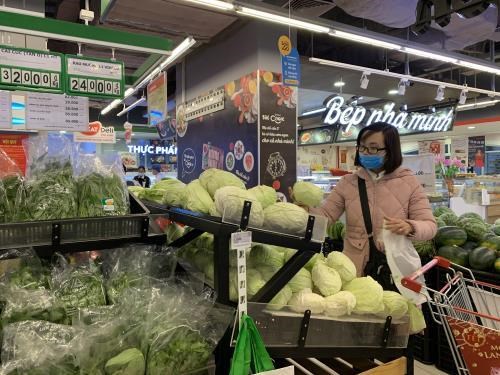February CPI falls by 0.17 percent
The February consumer price index (CPI) slipped 0.17 percent from the previous month due to falling demand for goods after Lunar New Year (Tet) holiday, falling petrol prices, and the coronavirus disease 2019 (COVID-19) outbreak, according to the General Statistics Office (GSO).

The February consumer price index (CPI) slips 0.17 percent from the previous month.(Photo: VNA)
The February consumer price index (CPI) slipped 0.17 percent from the previous month due to falling demand for goods after Lunar New Year (Tet) holiday, falling petrol prices, and the coronavirus disease 2019 (COVID-19) outbreak, according to the General Statistics Office (GSO).
Among 11 groups of products and services in the CPI basket, a decline was recorded in six groups: transport service (2.5 percent); culture, entertainment and tourism (0.43 percent); beverage and tobacco (0.28 percent); garment, head wear and footwear (0.13 percent); housing and building material (0.03 percent); and post and telecommunication services (0.05 percent).
Five groups with higher prices were restaurant and catering service (0.26 percent); other commodities and services (0.17 percent); medicine and medical services (0.13 percent); household appliances (0.08 percent); and education (0.04 percent).
Head of the GSO’s Price Statistics Department Do Thi Ngoc said that falling demands for goods after Tet made the prices of garment and textile, footwear, headwear, beverages and tobacco decrease.
She also said the decline in travel and festival activities due to the COVID-19 outbreak was behind the fall in prices of tourism, hotel and entertainment services.
In addition, prices of fresh and processed fruits dropped in the month as exports were impacted by close control at several border gates during the disease outbreak.
Ngoc added that petrol prices were adjusted down on February 14, contributing to a 0.22 percent fall of the CPI.
Meanwhile, there were some factors helping curb the CPI uptrend, Ngoc said, noting that the COVID-19 outbreak since January pushed prices of medicine up 0.18 percent from the previous month.
Demand for power and water upped 0.44 percent and 0.64 percent, respectively, in February as schools were closed and students stayed at home as a caution amid the COVID-19 threat, Ngoc stated, adding prices of vegetables also rose significantly in February due to shortage of supply caused by hailstones rain in the north and saline intrusion in the Mekong Delta region.
In February, gold prices moved in tandem with global gold prices, surging 2.74 percent from January to hover around 4.45 million VND (192.12 USD) per tael. Gold prices increased as investors move to invest in safer assets due to fear of a cloudy economic prospect caused by the COVID-19 outbreak.
The VND/USD exchange rate was kept stable, with one USD exchanged for 23,300 VND, thanks to abundant foreign currency reserves of the State Bank.
The GSO said that core inflation (CPI excluding food items, energy products and commodities under the State management like medical and educational services) in February inched up 0.17 percent from January, and 2.94 percent from a year ago. The two-month core inflation climbed 3.1 percent from the same period in 2019./.
VNA
 Vietnam needs 14 billion USD to develop EV charging stations
Vietnam needs 14 billion USD to develop EV charging stations
 Bright prospects in exports
Bright prospects in exports
 Focus on infrastructure development increases investment attraction
Focus on infrastructure development increases investment attraction
 Today (December 11), the conference to announce the Construction Planning of Phu Giao District until 2040 took place
Today (December 11), the conference to announce the Construction Planning of Phu Giao District until 2040 took place
 To ensure power grid safety for Tet
To ensure power grid safety for Tet
Regulations on food safety in fields managed by industry and trade sector
 Provincial e-commerce: Journey to conquer digital market
Provincial e-commerce: Journey to conquer digital market
 Optimistic about prospects, FDI capital into Binh Duong on increase
Optimistic about prospects, FDI capital into Binh Duong on increase
 OCOP products promoted at shopping centers
OCOP products promoted at shopping centers
 Urgently completing key traffic infrastructure projects
Urgently completing key traffic infrastructure projects






